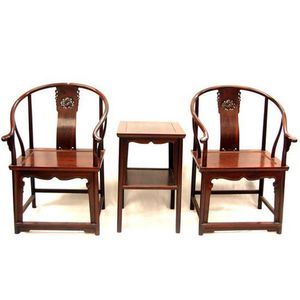Ming-style Zitan Armchairs and Centre Table
You must be a subscriber, and be logged in to view price and dealer details.
Subscribe Now to view actual auction price for this item
When you subscribe, you have the option of setting the currency in which to display prices to $Au, $US, $NZ or Stg.
- Ming Dynasty - The Ming Dynasty was a ruling dynasty of China from 1368 to 1644. It succeeded the Yuan Dynasty and preceded the Qing Dynasty. The Ming Dynasty was established by Zhu Yuanzhang, a former Buddhist monk who became a rebel leader and eventually overthrew the Mongol Yuan Dynasty. During the Ming Dynasty, China experienced a period of relative stability and prosperity. The government was centralized and bureaucratic, with the emperor at the top of the hierarchy. The Ming Dynasty is known for its cultural achievements, including the development of porcelain, the invention of movable type printing, and the construction of the Great Wall of China.
- Zitan Wood - Zitan is the most expensive, and since ancient times, has been considered the most precious of woods.
Zitan wood is the hardest and heaviest of all hardwoods. It is purplish-black to black in colour, and with a grain so dense it is virtually invisible.
Zitan can usually only be obtained in quite narrow strips and so it is rare to find large pieces of furniture made from this wood. True Chinese rosewood is a variety of zitan and is very rare. - Qing Dynasty - The Qing Dynasty was the last imperial dynasty of China, ruling from 1644 to 1912. It was established by the Manchu people, who originated from the northeastern region of China. The Qing Dynasty was preceded by the Ming Dynasty and followed by the Republic of China.
- Cartouche - An ornamental panel in the form of of a shield, oval or rectangular scroll with curling edges. It may be carved into the back of a chair or the top of a sideboard, or present on a piece of silver or jewellery, and contain the initials of the original owner, heraldic symbols, or some other inscription, such as the details of a presentation.
In ceramics the term defines the central area of a vase or similar with a decorative border in one of the shapes above, into which a decorative scene or figures have been painted.
This item has been included into following indexes:
- Chinese antiquities by dynasty - Ming Dynasty 1,266
- Chinese furniture, chairs
- Chinese furniture, timbers - zitan wood 34
Visually similar items

An amber bead necklace, graduated strand of 1318 mm round beads, length 112 cm.

Hermes, miniature bag, green leather with gold hardware including five protective studs to base and a removal shoulder strap, stamped 'Hermes Paris Made in France' to inside, with dustbag and box. Height 12.5 cm

9ct diamond ring, twenty-eight graduated diamonds in 9 carat yellow gold. Size M 1/2. Weight 4.3g

A Trumeau mirror in Louis XV style, with a painted panel of 18th century figures above a rectangular plate within a gilt frame surmounted with carved ribbon decoration, 120 cm high, 61 cm wide
